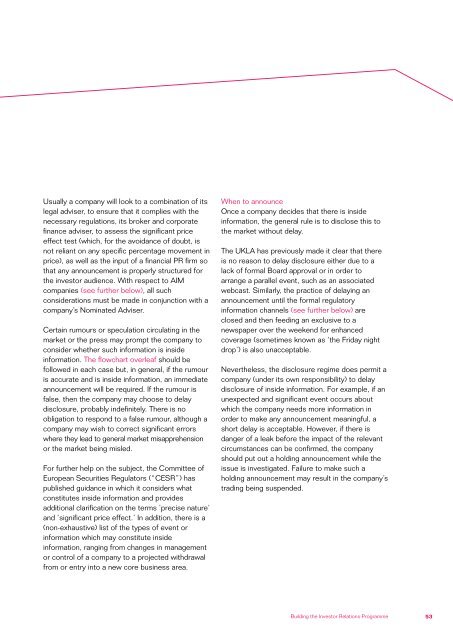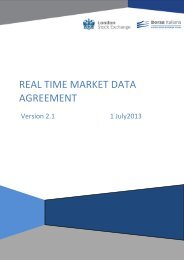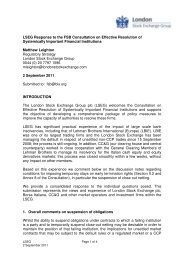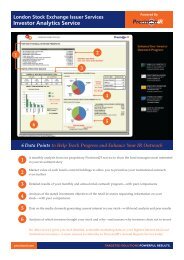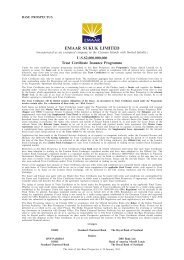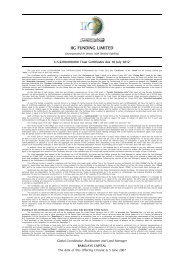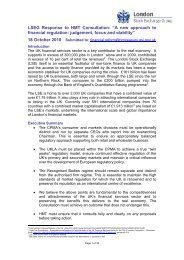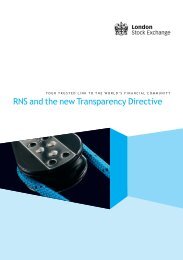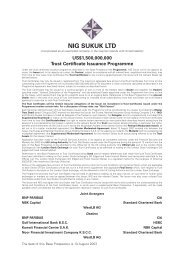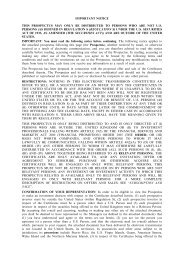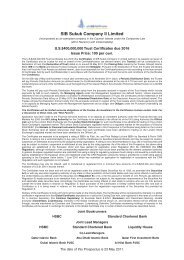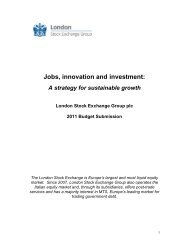Investor Relations - A Practical Guide - Investis
Investor Relations - A Practical Guide - Investis
Investor Relations - A Practical Guide - Investis
You also want an ePaper? Increase the reach of your titles
YUMPU automatically turns print PDFs into web optimized ePapers that Google loves.
Usually a company will look to a combination of its<br />
legal adviser, to ensure that it complies with the<br />
necessary regulations, its broker and corporate<br />
finance adviser, to assess the significant price<br />
effect test (which, for the avoidance of doubt, is<br />
not reliant on any specific percentage movement in<br />
price), as well as the input of a financial PR firm so<br />
that any announcement is properly structured for<br />
the investor audience. With respect to AIM<br />
companies (see further below), all such<br />
considerations must be made in conjunction with a<br />
company’s Nominated Adviser.<br />
Certain rumours or speculation circulating in the<br />
market or the press may prompt the company to<br />
consider whether such information is inside<br />
information. The flowchart overleaf should be<br />
followed in each case but, in general, if the rumour<br />
is accurate and is inside information, an immediate<br />
announcement will be required. If the rumour is<br />
false, then the company may choose to delay<br />
disclosure, probably indefinitely. There is no<br />
obligation to respond to a false rumour, although a<br />
company may wish to correct significant errors<br />
where they lead to general market misapprehension<br />
or the market being misled.<br />
For further help on the subject, the Committee of<br />
European Securities Regulators (“CESR”) has<br />
published guidance in which it considers what<br />
constitutes inside information and provides<br />
additional clarification on the terms ‘precise nature’<br />
and ‘significant price effect.’ In addition, there is a<br />
(non-exhaustive) list of the types of event or<br />
information which may constitute inside<br />
information, ranging from changes in management<br />
or control of a company to a projected withdrawal<br />
from or entry into a new core business area.<br />
When to announce<br />
Once a company decides that there is inside<br />
information, the general rule is to disclose this to<br />
the market without delay.<br />
The UKLA has previously made it clear that there<br />
is no reason to delay disclosure either due to a<br />
lack of formal Board approval or in order to<br />
arrange a parallel event, such as an associated<br />
webcast. Similarly, the practice of delaying an<br />
announcement until the formal regulatory<br />
information channels (see further below) are<br />
closed and then feeding an exclusive to a<br />
newspaper over the weekend for enhanced<br />
coverage (sometimes known as ‘the Friday night<br />
drop’) is also unacceptable.<br />
Nevertheless, the disclosure regime does permit a<br />
company (under its own responsibility) to delay<br />
disclosure of inside information. For example, if an<br />
unexpected and significant event occurs about<br />
which the company needs more information in<br />
order to make any announcement meaningful, a<br />
short delay is acceptable. However, if there is<br />
danger of a leak before the impact of the relevant<br />
circumstances can be confirmed, the company<br />
should put out a holding announcement while the<br />
issue is investigated. Failure to make such a<br />
holding announcement may result in the company’s<br />
trading being suspended.<br />
Building the <strong>Investor</strong> <strong>Relations</strong> Programme 53


